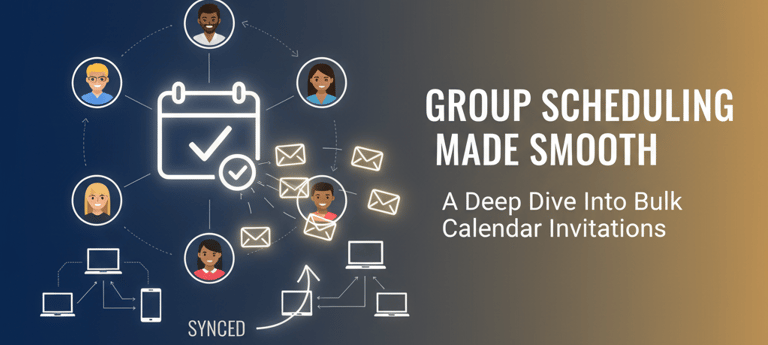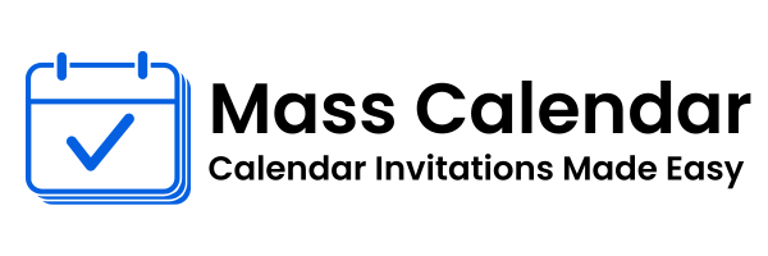How to Manage Group Scheduling Smoothly: A Deep Dive Into Bulk Calendar Invitations
Scheduling a meeting with one or two people is easy. But coordinating dozens or even hundreds of attendees is a completely different challenge. Businesses today host frequent webinars, workshops, internal training sessions, onboarding meetings, and virtual events all of which require sending coordinated calendar invitations at scale.
BLOG
11/17/20253 min read


Scheduling a meeting with one or two people is easy. But coordinating dozens or even hundreds of attendees is a completely different challenge. Businesses today host frequent webinars, workshops, internal training sessions, onboarding meetings, and virtual events all of which require sending coordinated calendar invitations at scale.
This blog explores how organizations can streamline group scheduling, ensure clear communication, and create a smooth workflow for sending invitations efficiently.
Why Bulk Scheduling Is Becoming Essential
Modern workplaces operate in different locations, across varied time zones, and through hybrid or remote work structures. Communication can become scattered without a proper planning structure, especially when you need to send mass meeting invites.
With more communication channels and virtual collaboration platforms, a unified scheduling process ensures:
No missed invitations
Consistent details for every attendee
Reduced manual work
Faster organization
Improved attendance rates
These factors make standardized bulk scheduling an essential part of event or meeting coordination.
Understanding How Calendar Invites Work
Calendar invites serve as automated digital meeting requests. Once the recipient accepts the request, the meeting automatically appears on their calendar. This removes confusion, prevents scheduling errors, and helps attendees stay organized.
Whether you’re using Google Calendar, Outlook, or another system, managing the process as a bulk calendar initiative delivers consistency and professionalism.
Common Problems When Sending Group Invites
Most people begin with manual scheduling and soon face issues like:
1. Recipient Errors
Wrong email IDs, missing attendees, or someone being added twice.
2. Version Confusion
People receiving different meeting details or updated timings.
3. Time Zone Issues
A single mistake can lead to incomplete attendance.
4. Difficulty Tracking Responses
It becomes hard to identify who accepted or declined.
5. Managing Follow-ups
Sending reminder messages to large groups manually consumes time.
A systematic approach is necessary to avoid these common challenges.
Sending Bulk Calendar Invites With Gmail
Google Calendar is simple and efficient for large group scheduling. A bulk calendar invite in Gmail allows you to:
Add groups instead of individual contacts
Attach video call links
Include location details
Add attachments or notes
Set recurring schedules
Its clean interface and automation options make it suitable for regular team meetings or large public-facing events.
Scheduling Mass Meetings Using Outlook
Outlook’s scheduling system is especially favored in corporate environments. When you need to send mass meeting invites in Outlook, you get access to:
Distribution groups
Organizational address lists
Room scheduling
Automatic reminders
Time zone detection
For many companies, the ability to send bulk meeting invite in Outlook helps streamline structured internal communication.
Planning an Effective Meeting Invitation
To ensure your bulk calendar process works well, keep these guidelines in mind:
1. Keep the Subject Line Clear
It should instantly tell attendees what the meeting is about.
2. Add a Proper Description
Include details such as:
Purpose
Agenda
Instructions
Important links
Attachments
Location
3. Make the Timing Clear
Avoid time zone confusion by using automatic time conversion or specifying zones explicitly.
4. Keep Recipients Organized
Using mailing groups instead of individual addresses ensures consistency.
Handling Updates and Reminders
If the meeting details change:
Update the calendar invite directly
Keep text concise
Send minimal revisions to avoid confusion
Most calendar platforms also send reminders automatically, which reduces the need for manual follow-ups.
Respect Attendees’ Time
When scheduling large meetings:
Avoid overlapping with major holidays
Consider time zone fairness
Keep meetings short unless necessary
Use agendas to keep the session productive
Structure and respect go a long way in improving engagement.
Maintaining Consistency for Recurring Meetings
If you host recurring events, workshops, or monthly team sessions, creating a repeatable system saves significant time. Recurring calendar invites ensure that attendees stay updated without receiving fresh emails every time.
For large events, maintaining consistency helps build trust and sets clear expectations.
Conclusion
Whether you're scheduling internal team updates, webinars, onboarding sessions, or large training programs, handling invites at scale requires a reliable, organized approach. Using tools like Google Calendar or Outlook, combined with structured planning, helps create a smooth and professional workflow.
As your organization grows, bulk scheduling will continue to play an important role helping you stay coordinated, connected, and productive
MassCalendar.in
Send Bulk & Mass Calendar Invites Instantly
CONTACT
Meetings
+44 (0) 203 916 5117
© 2025. All rights reserved.
Help?
